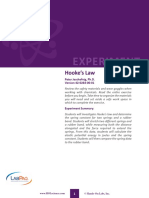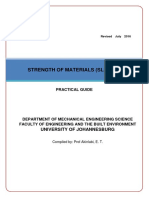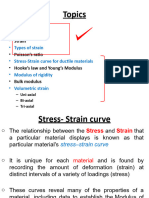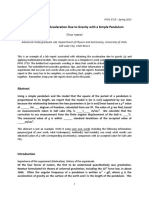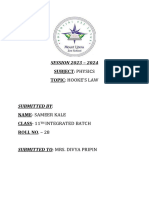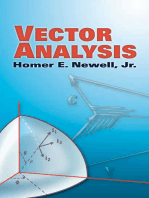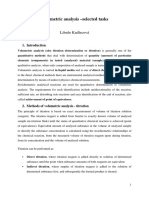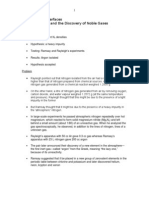Law of Hooke
Law of Hooke
Uploaded by
ashishtelang2013Copyright:
Available Formats
Law of Hooke
Law of Hooke
Uploaded by
ashishtelang2013Original Description:
Original Title
Copyright
Available Formats
Share this document
Did you find this document useful?
Is this content inappropriate?
Copyright:
Available Formats
Law of Hooke
Law of Hooke
Uploaded by
ashishtelang2013Copyright:
Available Formats
Measuring Hookes Law
You MUST investigate and use Hookes Law, F = kx, and know that it applies only to some materials
You SHOULD identify the uncertainty in measurements. (Most)
You COULD calculate the elastic strain energy Eel in a deformed material sample, using the expression Eel =
1/2Fx, and from the area under its force/extension graph
Lets get into the Delorean
Keywords Elastic Behavior, Plastic Deformation, Directly Proportional
Measuring Hookes Law
You MUST investigate and use Hookes Law, F = kx, and know that it applies only to some materials
You SHOULD identify the uncertainty in measurements. (Most)
You COULD calculate the elastic strain energy Eel in a deformed material sample, using the expression Eel =
1/2Fx, and from the area under its force/extension graph
Task
Identify the relationship between force and extension
of a spring.
Use PowerPoint on VLE to draw correct table, decide
whether it is directly or inversely proportional, to
identify dependent, independent and control
variables and calculate the uncertainty.
Draw a graph. Graph should include results from all 3
experiments and have 3 separate lines of best fit.
Use work done equation and graph to calculate
elastic strain energy.
Keywords Elastic Behavior, Plastic Deformation, Directly Proportional
Measuring Hookes Law
You MUST investigate and use Hookes Law, F = kx, and know that it applies only to some materials
You SHOULD identify the uncertainty in measurements. (Most)
You COULD calculate the elastic strain energy Eel in a deformed material sample, using the expression Eel =
1/2Fx, and from the area under its force/extension graph
Results tables
3.05
0.14
0.15
0.13
0.14
Headings should be clear
Physical quantities should have units
All measurements should be recorded (not just the average)
Correct s.f. should be used.
The average should have the same number of s.f. as the original
measurements.
Keywords Elastic Behavior, Plastic Deformation, Directly Proportional
Measuring Hookes Law
You MUST investigate and use Hookes Law, F = kx, and know that it applies only to some materials
You SHOULD identify the uncertainty in measurements. (Most)
You COULD calculate the elastic strain energy Eel in a deformed material sample, using the expression Eel =
1/2Fx, and from the area under its force/extension graph
Force (N)
Extension (cm)
Test 1
Test 2
Test 3
Mean
Keywords Elastic Behavior, Plastic Deformation, Directly Proportional
Measuring Hookes Law
length of
spring
Each axis should be
labelled with a quantity
name (or symbol) and its
unit.
cm
You MUST investigate and use Hookes Law, F = kx, and know that it applies only to some materials
You SHOULD identify the uncertainty in measurements. (Most)
You COULD calculate the elastic strain energy Eel in a deformed material sample, using the expression Eel =
1/2Fx, and from the area under its force/extension graph
F
N
Keywords Elastic Behavior, Plastic Deformation, Directly Proportional
Measuring Hookes Law
You MUST investigate and use Hookes Law, F = kx, and know that it applies only to some materials
You SHOULD identify the uncertainty in measurements. (Most)
You COULD calculate the elastic strain energy Eel in a deformed material sample, using the expression Eel =
1/2Fx, and from the area under its force/extension graph
Both vertically and horizontally your points should
occupy at least half of the available graph paper
GOOD
POOR
AWFUL
Keywords Elastic Behavior, Plastic Deformation, Directly Proportional
Measuring Hookes Law
You MUST investigate and use Hookes Law, F = kx, and know that it applies only to some materials
You SHOULD identify the uncertainty in measurements. (Most)
You COULD calculate the elastic strain energy Eel in a deformed material sample, using the expression Eel =
1/2Fx, and from the area under its force/extension graph
Best fit lines
Best fit lines can be curves!
The line should be drawn so that
there are roughly the same
number of points above and
below.
too steep
too high
too low
correct
too
shallow
Anomalous points should be
rechecked. If this is not possible
they should be ignored when
drawing the best-fit line
Keywords Elastic Behavior, Plastic Deformation, Directly Proportional
Measuring Hookes Law
You MUST investigate and use Hookes Law, F = kx, and know that it applies only to some materials
You SHOULD identify the uncertainty in measurements. (Most)
You COULD calculate the elastic strain energy Eel in a deformed material sample, using the expression Eel =
1/2Fx, and from the area under its force/extension graph
Measuring gradients
gradient = y-step (y)
x-step (x)
The triangle used to find the
gradient should be shown on the
graph.
Each side of the triangle should
be at least 8cm long.
Gradients usually have a unit.
Keywords Elastic Behavior, Plastic Deformation, Directly Proportional
Measuring Hookes Law
You MUST investigate and use Hookes Law, F = kx, and know that it applies only to some materials
You SHOULD identify the uncertainty in measurements. (Most)
You COULD calculate the elastic strain energy Eel in a deformed material sample, using the expression Eel =
1/2Fx, and from the area under its force/extension graph
Direct proportion
Physical quantities are directly
proportional to each other if when one of
them is doubled the other will also double.
A graph of two quantities that are directly
proportional to each other will be:
y
m
a straight line
AND pass through the origin
The general equation of the straight line in this
case is: y = mx, in this case, c = 0
Keywords Elastic Behavior, Plastic Deformation, Directly Proportional
Measuring Hookes Law
You MUST investigate and use Hookes Law, F = kx, and know that it applies only to some materials
You SHOULD identify the uncertainty in measurements. (Most)
You COULD calculate the elastic strain energy Eel in a deformed material sample, using the expression Eel =
1/2Fx, and from the area under its force/extension graph
Inverse proportion
Physical quantities are inversely
proportional to each other if when one of
them is doubled the other will halve.
A graph of two quantities that are inversely
proportional to each other will be:
a rectangular hyperbola
has no y- or x-intercept
Inverse proportion can be verified by drawing
a graph of y against 1/x.
This should be:
a straight line
AND pass through the origin
x
y
1/x
The general equation of the straight line in
this case is: y = m / x
Keywords Elastic Behavior, Plastic Deformation, Directly Proportional
Measuring Hookes Law
You MUST investigate and use Hookes Law, F = kx, and know that it applies only to some materials
You SHOULD identify the uncertainty in measurements. (Most)
You COULD calculate the elastic strain energy Eel in a deformed material sample, using the expression Eel =
1/2Fx, and from the area under its force/extension graph
Mean value <x>
Mean value calculated by adding the readings
together and dividing by the number of
readings.
Readings: 45g; 44g; 44g; 47g; 46g; 45g
Mean value of mass <m>:
= (45+44+44+47+46+45) / 6
<m> = 45.2 g
Keywords Elastic Behavior, Plastic Deformation, Directly Proportional
Measuring Hookes Law
You MUST investigate and use Hookes Law, F = kx, and know that it applies only to some materials
You SHOULD identify the uncertainty in measurements. (Most)
You COULD calculate the elastic strain energy Eel in a deformed material sample, using the expression Eel =
1/2Fx, and from the area under its force/extension graph
The uncertainty (or probable error) in
the mean value of a measurement is
half the range expressed as a value
Example: If mean mass is 45.2g and the
range is 3g then:
The probable error (uncertainty) is 1.5g
Keywords Elastic Behavior, Plastic Deformation, Directly Proportional
Measuring Hookes Law
You MUST investigate and use Hookes Law, F = kx, and know that it applies only to some materials
You SHOULD identify the uncertainty in measurements. (Most)
You COULD calculate the elastic strain energy Eel in a deformed material sample, using the expression Eel =
1/2Fx, and from the area under its force/extension graph
Uncertainty in a single reading
OR when measurements do not vary
The probable error is
equal to the precision in
reading the instrument
For the scale opposite
this would be:
0.1 without the magnifying
glass
0.02 perhaps with the
magnifying glass
Keywords Elastic Behavior, Plastic Deformation, Directly Proportional
Measuring Hookes Law
You MUST investigate and use Hookes Law, F = kx, and know that it applies only to some materials
You SHOULD identify the uncertainty in measurements. (Most)
You COULD calculate the elastic strain energy Eel in a deformed material sample, using the expression Eel =
1/2Fx, and from the area under its force/extension graph
Percentage uncertainty
percentage uncertainty = probable error x 100%
measurement
Example: Calculate the % uncertainty the mass
measurement 45 2g
percentage uncertainty = 2g x 100%
45g
= 4.44 %
Keywords Elastic Behavior, Plastic Deformation, Directly Proportional
Measuring Hookes Law
You MUST investigate and use Hookes Law, F = kx, and know that it applies only to some materials
You SHOULD identify the uncertainty in measurements. (Most)
You COULD calculate the elastic strain energy Eel in a deformed material sample, using the expression Eel =
1/2Fx, and from the area under its force/extension graph
Combining percentage uncertainties
1.
Multiplication or Division
Add the percentage uncertainties together.
Examples:
1. Calculate the percentage uncertainty in force causing a
mass of 50kg 10% to accelerate by 20 ms -2 5%.
F = ma
Hence force = 1000N 15% (10% plus 5%)
2. Calculate the percentage uncertainty in the density of a
material of mass 300g 5% and volume 60cm3 2%.
D=M/V
Hence density = 5.0 gcm-3 7% (5% plus 2%)
Keywords Elastic Behavior, Plastic Deformation, Directly Proportional
Measuring Hookes Law
You MUST investigate and use Hookes Law, F = kx, and know that it applies only to some materials
You SHOULD identify the uncertainty in measurements. (Most)
You COULD calculate the elastic strain energy Eel in a deformed material sample, using the expression Eel =
1/2Fx, and from the area under its force/extension graph
Significant figures and uncertainty
The percentage uncertainty in a measurement or calculation
determines the number of significant figures to be used.
Example:
mass = 4.52g 10%
10% of 4.52g is 0.452g
The uncertainty should be quoted to 1sf only. i.e. 0.5g
The quantity value (4.52) should be quoted to the same
decimal places as the 1sf uncertainty value. i.e. 4.5
The mass value will now be quoted to only 2sf.
mass = 4.5 0.5g
Keywords Elastic Behavior, Plastic Deformation, Directly Proportional
Measuring Hookes Law
You MUST investigate and use Hookes Law, F = kx, and know that it applies only to some materials
You SHOULD identify the uncertainty in measurements. (Most)
You COULD calculate the elastic strain energy Eel in a deformed material sample, using the expression Eel =
1/2Fx, and from the area under its force/extension graph
Hookes law
The force (F ) needed to stretch a spring is directly
proportional to the extension (L ) of a spring from its
natural length.
F L
Adding a constant of proportionality:
F = k L
k is called the spring constant
The spring constant is the force required to produce an
extension of one metre.
unit = Nm-1
Keywords Elastic Behavior, Plastic Deformation, Directly Proportional
Measuring Hookes Law
You MUST investigate and use Hookes Law, F = kx, and know that it applies only to some materials
You SHOULD identify the uncertainty in measurements. (Most)
You COULD calculate the elastic strain energy Eel in a deformed material sample, using the expression Eel =
1/2Fx, and from the area under its force/extension graph
Elastic limit
Up to a certain extension if the force is removed the
spring will return to its original length. The spring is
said to be behaving elastically.
If this critical extension is exceeded, known as the
elastic limit, the spring will be permanently stretched.
Plastic behaviour then occurs and Hookes law is no
longer obeyed by the spring.
Keywords Elastic Behavior, Plastic Deformation, Directly Proportional
Measuring Hookes Law
You MUST investigate and use Hookes Law, F = kx, and know that it applies only to some materials
You SHOULD identify the uncertainty in measurements. (Most)
You COULD calculate the elastic strain energy Eel in a deformed material sample, using the expression Eel =
1/2Fx, and from the area under its force/extension graph
Question
A spring of natural length
15cm is extended by 3cm
by a force of 6N. Calculate
(a) the spring constant and
(b) the length of the spring
if a force of 18N is applied.
(a) F = k L
k = F / L
= 6N / 0.03m
spring constant, k
= 200 Nm-1
(b) F = k L
L = F / k
= 18N / 200 Nm-1
L = 0.09 m
= 9 cm
And so the
springs length
= 24 cm
Keywords Elastic Behavior, Plastic Deformation, Directly Proportional
Measuring Hookes Law
You MUST investigate and use Hookes Law, F = kx, and know that it applies only to some materials
You SHOULD identify the uncertainty in measurements. (Most)
You COULD calculate the elastic strain energy Eel in a deformed material sample, using the expression Eel =
1/2Fx, and from the area under its force/extension graph
Elastic strain energy
force
The graph opposite shows
how the force varies as the
spring extends.
The work done in extending
the spring is given by:
work = force x distance
extension
Keywords Elastic Behavior, Plastic Deformation, Directly Proportional
Measuring Hookes Law
You MUST investigate and use Hookes Law, F = kx, and know that it applies only to some materials
You SHOULD identify the uncertainty in measurements. (Most)
You COULD calculate the elastic strain energy Eel in a deformed material sample, using the expression Eel =
1/2Fx, and from the area under its force/extension graph
Elastic strain energy
= average tensile force x extension
force
F
= F L
= area under the curve
= energy stored in the spring
area = F L
and so:
0
extension
elastic strain energy = F L
Keywords Elastic Behavior, Plastic Deformation, Directly Proportional
Measuring Hookes Law
You MUST investigate and use Hookes Law, F = kx, and know that it applies only to some materials
You SHOULD identify the uncertainty in measurements. (Most)
You COULD calculate the elastic strain energy Eel in a deformed material sample, using the expression Eel =
1/2Fx, and from the area under its force/extension graph
Answers
Complete:
tensile force
extension
strain energy
120 N
2m
120 J
40 N
15 cm
3J
3 kN
100
50 mm
2 MN
4
6 m
150 J
12 J
Keywords Elastic Behavior, Plastic Deformation, Directly Proportional
Measuring Hookes Law
You MUST investigate and use Hookes Law, F = kx, and know that it applies only to some materials
You SHOULD identify the uncertainty in measurements. (Most)
You COULD calculate the elastic strain energy Eel in a deformed material sample, using the expression Eel =
1/2Fx, and from the area under its force/extension graph
Question
A spring of original length 20cm
extends to 25cm when a weight
of 4N is hung from it. Calculate:
(a) the elastic strain energy
stored in the spring,
(b) the spring constant
(c) the length of the spring when
it is storing 0.5 J of energy.
(a) strain energy
= F L
= x 4N x 0.05m
strain energy
= 0.10 J
Keywords Elastic Behavior, Plastic Deformation, Directly Proportional
Measuring Hookes Law
You MUST investigate and use Hookes Law, F = kx, and know that it applies only to some materials
You SHOULD identify the uncertainty in measurements. (Most)
You COULD calculate the elastic strain energy Eel in a deformed material sample, using the expression Eel =
1/2Fx, and from the area under its force/extension graph
(b) F = k L
k = F / L = 4N / 0.05m
spring constant, k = 80 Nm-1
(c) strain energy = F L and F = k L when combined
give: strain energy = k (L)2
L = (2 x strain energy / k)
= (2 x 0.5 / 80)
= (0.0125)
= 0.112m
Therefore spring length = 20cm + 11.2cm
= 31.2 cm
Keywords Elastic Behavior, Plastic Deformation, Directly Proportional
You might also like
- Parts Catalog (EX1200-6 LC-Type - With 1000 1100 MM Shoes) (EPM18J-OP2-1)Document40 pagesParts Catalog (EX1200-6 LC-Type - With 1000 1100 MM Shoes) (EPM18J-OP2-1)Sonta Kuguh0% (1)
- Practical 1P2 Young's Modulus and Stress Analysis: What You Should Learn From This PracticalDocument10 pagesPractical 1P2 Young's Modulus and Stress Analysis: What You Should Learn From This Practicalahmadmn_scribdNo ratings yet
- Deformation of SolidsDocument31 pagesDeformation of SolidsWadood Ahmed100% (4)
- Experiment: Hooke's LawDocument12 pagesExperiment: Hooke's LawDee DadaNo ratings yet
- Hooke's Law-1Document16 pagesHooke's Law-1محمود مصطفىNo ratings yet
- 6 - Deformation of SolidsDocument31 pages6 - Deformation of SolidsTouhidul Islam SabidNo ratings yet
- MOM-I Topic-3 Mechanical PropertiesDocument44 pagesMOM-I Topic-3 Mechanical PropertiesNoor FatimaNo ratings yet
- 11 - Hooke's Law LabDocument3 pages11 - Hooke's Law LabvictortengckNo ratings yet
- Hooks LawDocument4 pagesHooks Lawapi-255078290100% (1)
- Module 3 Strain TransformationDocument40 pagesModule 3 Strain Transformationcheetahmax07No ratings yet
- 9702 P5 Q1Document4 pages9702 P5 Q1Michael LeungNo ratings yet
- Steel Tensile TestDocument10 pagesSteel Tensile Testafiq2697No ratings yet
- 2016 Practical Guide PDFDocument9 pages2016 Practical Guide PDFPromiseDoringtenNkosiNo ratings yet
- The Annual Käs Lab X-Mas Bash 2013: When: December 14, 7pm Where: Feuerbachstr, 4, LeipzigDocument35 pagesThe Annual Käs Lab X-Mas Bash 2013: When: December 14, 7pm Where: Feuerbachstr, 4, LeipzigAlejandro LavradorNo ratings yet
- G 204 ContentDocument30 pagesG 204 ContentRajNo ratings yet
- Physics ProjectDocument26 pagesPhysics ProjectCH Tarakeesh75% (8)
- Mos Lec-2Document16 pagesMos Lec-2zubairNo ratings yet
- Determining The Acceleration Due To Gravity With A Simple PendulumDocument7 pagesDetermining The Acceleration Due To Gravity With A Simple Pendulumah maNo ratings yet
- 9702 Nos Ps 5 PDFDocument4 pages9702 Nos Ps 5 PDFDe NimNo ratings yet
- Tensile TestDocument8 pagesTensile TestsuhanbekalNo ratings yet
- Physics Lab Presentation: Environmental/Safety Impacts of Selected IndustriesDocument24 pagesPhysics Lab Presentation: Environmental/Safety Impacts of Selected Industrieshanif274No ratings yet
- Lab05 Candy LabDocument14 pagesLab05 Candy LabJason Paul RoqueNo ratings yet
- Doppler and Photoelectric Effects Revision Material 2023Document55 pagesDoppler and Photoelectric Effects Revision Material 2023ofentsesebothelo92No ratings yet
- Chapter 1 - Physics and MeasurementDocument18 pagesChapter 1 - Physics and MeasurementJasmin TajudinNo ratings yet
- Hooke's Law ExperimentDocument4 pagesHooke's Law ExperimentMarini Tampubolon100% (1)
- Stress..strain in Thick PlatesDocument63 pagesStress..strain in Thick PlatesHitesh MudgilNo ratings yet
- Notes MaterialsDocument6 pagesNotes Materialsapi-354495352No ratings yet
- Mechanical Testing of MaterialsDocument6 pagesMechanical Testing of MaterialsAbhijeet P. DashNo ratings yet
- PhysicsDocument16 pagesPhysicsnc202674No ratings yet
- Hooke Law Lab ReportDocument10 pagesHooke Law Lab ReportasifNo ratings yet
- Mme 223 Report 2Document8 pagesMme 223 Report 2api-272897083No ratings yet
- Alevels P5 AlloverDocument11 pagesAlevels P5 AlloverRida TararNo ratings yet
- Strength of Material Exp 5 Impact TestDocument14 pagesStrength of Material Exp 5 Impact Testhayder alaliNo ratings yet
- Physics 2 Lab ManualDocument104 pagesPhysics 2 Lab ManualJeanne JacksonNo ratings yet
- Hooke's LawDocument19 pagesHooke's Lawraj33singh75No ratings yet
- Hooke's LawDocument18 pagesHooke's LawIznifaiznur Faiznur0% (2)
- Hooke's Law: Lab ObjectivesDocument6 pagesHooke's Law: Lab ObjectivesJabar BazeedNo ratings yet
- Lab 02Document6 pagesLab 02yasirlatif8383No ratings yet
- Hooke Law ExperimentDocument2 pagesHooke Law ExperimentmohammedbouhaddachepersonalNo ratings yet
- Young's ModulusDocument3 pagesYoung's ModulusRjNo ratings yet
- Mechanical PropertiesDocument77 pagesMechanical PropertiesGerd FreeNo ratings yet
- Experiment 1Document23 pagesExperiment 1Sofyan HadiNo ratings yet
- Notes - Topic 9 Deformation of Solids - CAIE Physics A-LevelDocument4 pagesNotes - Topic 9 Deformation of Solids - CAIE Physics A-LevelMEENUNo ratings yet
- P Unite 1 SpecificationDocument5 pagesP Unite 1 SpecificationSadeed SulemanNo ratings yet
- Material and Manufacturing Lab ReportDocument41 pagesMaterial and Manufacturing Lab Reportperiodictable350No ratings yet
- General Rules:: PhysicsDocument13 pagesGeneral Rules:: PhysicsYoussef AhmedNo ratings yet
- Specimen Design and Its Effects For Kolsky Bar ExperimenmtDocument11 pagesSpecimen Design and Its Effects For Kolsky Bar ExperimenmtYuvaraj Reddy ChitelaNo ratings yet
- KD - KC 2022 - G6 Criteria B and C Lab Report TemplateDocument9 pagesKD - KC 2022 - G6 Criteria B and C Lab Report Templateyouyoonseo04880No ratings yet
- Physical Sciences GR 11 Assessment Frame June 2023 ENGDocument6 pagesPhysical Sciences GR 11 Assessment Frame June 2023 ENGmm.memaniNo ratings yet
- Experiment 4 - Testing of Materials in Tension: Engineering Stress (Lbs/inDocument4 pagesExperiment 4 - Testing of Materials in Tension: Engineering Stress (Lbs/inneel12321No ratings yet
- Physics Mefie New New PrintoutDocument15 pagesPhysics Mefie New New Printoutarleen.mefie.mjNo ratings yet
- ESA Units - 1 2 3Document135 pagesESA Units - 1 2 3Abhi ShekNo ratings yet
- Static FrictionDocument14 pagesStatic Frictionlanelowes594No ratings yet
- 321 Exam Questions on Planning ExperimentsDocument4 pages321 Exam Questions on Planning Experimentskaartigan.ganeshNo ratings yet
- IIT Physics Lab Manual (Combined)Document34 pagesIIT Physics Lab Manual (Combined)Victoria Aschebrook-KealiherNo ratings yet
- Course 1 Laboratory: Second Semester Experiment: Young's ModulusDocument6 pagesCourse 1 Laboratory: Second Semester Experiment: Young's ModulusPatrick SibandaNo ratings yet
- An Introduction to the Theory of ElasticityFrom EverandAn Introduction to the Theory of ElasticityRating: 4.5 out of 5 stars4.5/5 (2)
- Atmosphere and Weather Mark SchemesDocument12 pagesAtmosphere and Weather Mark Schemesashishtelang2013No ratings yet
- ICT Exam Paper 2012 Winter GCE AlevelDocument8 pagesICT Exam Paper 2012 Winter GCE AlevelhbytheonlyNo ratings yet
- Youngs ModulusDocument4 pagesYoungs Modulusashishtelang2013100% (1)
- Upstrea M Downstrea M: DischargeDocument2 pagesUpstrea M Downstrea M: Dischargeashishtelang2013No ratings yet
- Word Equation And/ or Example Experiment And/or Diagram: Laminar FlowDocument3 pagesWord Equation And/ or Example Experiment And/or Diagram: Laminar Flowashishtelang2013No ratings yet
- Human Impact On Rivers - NILEDocument1 pageHuman Impact On Rivers - NILEashishtelang2013No ratings yet
- Kevlar Bullet Proof: Kevlar Is A Material That Is Used in Making Bulletproof Jackets and VestsDocument2 pagesKevlar Bullet Proof: Kevlar Is A Material That Is Used in Making Bulletproof Jackets and Vestsashishtelang2013No ratings yet
- Internal Migration MEDC'sDocument1 pageInternal Migration MEDC'sashishtelang2013No ratings yet
- ch10 Genius EducationDocument69 pagesch10 Genius Educationt74625993No ratings yet
- Volumetric Analysis TheoryDocument8 pagesVolumetric Analysis Theoryarun231187No ratings yet
- Unified Formula For Alpha DecayDocument6 pagesUnified Formula For Alpha DecayWritam SenguptaNo ratings yet
- Guide For The Application of Neutral Grounding in Electrical Utility Systems, Part V - Transmission Systems and Subtransmission SystemsDocument4 pagesGuide For The Application of Neutral Grounding in Electrical Utility Systems, Part V - Transmission Systems and Subtransmission SystemskrcdewanewNo ratings yet
- Chap07 External Forced ConvectionDocument39 pagesChap07 External Forced ConvectionDilara ŞimşekNo ratings yet
- William RamsayDocument5 pagesWilliam RamsayNicholas OwNo ratings yet
- Matter in Our Surroundings (Prashant Kirad)Document41 pagesMatter in Our Surroundings (Prashant Kirad)nidhimathapati123No ratings yet
- Cambridge International AS & A Level: Further Mathematics 9231/32Document16 pagesCambridge International AS & A Level: Further Mathematics 9231/327fhhnrxgnyNo ratings yet
- Gauge Theories Lecture Notes by Matthew de AngelisDocument84 pagesGauge Theories Lecture Notes by Matthew de Angeliscifarha venant100% (1)
- Kuan 2009 AppendixDocument14 pagesKuan 2009 AppendixMohammed EljammalNo ratings yet
- DuPont TiO2 Coatings BrochureDocument28 pagesDuPont TiO2 Coatings Brochuredello123No ratings yet
- BSC4YearSystem PDFDocument19 pagesBSC4YearSystem PDFBloom NepalNo ratings yet
- Coach & Wagon BogiesDocument156 pagesCoach & Wagon BogiesAmanpreet Singh100% (1)
- Notes 4 3317 Maxwell's EquationsDocument39 pagesNotes 4 3317 Maxwell's EquationsDiyaNo ratings yet
- Kinematics: Description of Motion: Important TermsDocument13 pagesKinematics: Description of Motion: Important TermsLOYAGA Mikaela,No ratings yet
- 7 - Transformation of Stress and StrainDocument22 pages7 - Transformation of Stress and StrainMehmet CiglaNo ratings yet
- Thesis Thin Film Solar CellDocument9 pagesThesis Thin Film Solar Cellfjfsyk5w100% (2)
- Shallow Foundations Allowable Bearing Capacity & SettlementDocument22 pagesShallow Foundations Allowable Bearing Capacity & SettlementMansoorNo ratings yet
- Vibrations of Single Degree of Freedom Systems: M X (T) F (T) KDocument25 pagesVibrations of Single Degree of Freedom Systems: M X (T) F (T) KIbraheem OlugbadeNo ratings yet
- JEE Main 2024 (30 Jan Shift 2) Previous Year Paper With Answer Keys - MathonGoDocument14 pagesJEE Main 2024 (30 Jan Shift 2) Previous Year Paper With Answer Keys - MathonGoKeshavNo ratings yet
- Physics: SCIENCE Paper - 1Document9 pagesPhysics: SCIENCE Paper - 1chaituNo ratings yet
- MomentumDocument7 pagesMomentumdrkhansacademyNo ratings yet
- F322 01jun13Document24 pagesF322 01jun13cozzy'mozzy..dozzy.;No ratings yet
- The Ramachandran PlotDocument2 pagesThe Ramachandran PlotParth sarthi Sen guptaNo ratings yet
- DC Current Interruption in HVDC SF6 Gas MRTB by Means of Self-Excited Oscillation SuperimpositionDocument7 pagesDC Current Interruption in HVDC SF6 Gas MRTB by Means of Self-Excited Oscillation SuperimpositionaNo ratings yet
- Coplanar ForcesDocument3 pagesCoplanar ForcesMuyanja FahdNo ratings yet
- Analogue Electronics IV Assignment 1Document6 pagesAnalogue Electronics IV Assignment 1Phelix PheloNo ratings yet
- 1.3-1.4 Scalar N VectorDocument54 pages1.3-1.4 Scalar N VectorandreaNo ratings yet
- Singular Value Decomposition and Polar FormDocument24 pagesSingular Value Decomposition and Polar FormmaxxagainNo ratings yet




